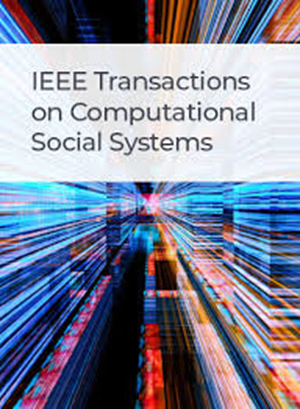Understanding Inciting Speech as New Malice
IF 4.5
2区 计算机科学
Q1 COMPUTER SCIENCE, CYBERNETICS
IEEE Transactions on Computational Social Systems
Pub Date : 2025-01-27
DOI:10.1109/TCSS.2024.3504357
引用次数: 0
Abstract
Inciting speech seeks to instill hostility or anger in readers or motivate them to take action against a target group. Whereas hate speech in social media has garnered much attention, inciting speech has not been well studied in domains such as religion. We address two aspects of religious incitement: 1) what rhetorical strategies are used in it?; and 2) do the same strategies apply across disparate social contexts and targets? We identify inciting speech against Muslims but demonstrate the generality of the construct vis à vis other targets. We adopt existing datasets of Islamophobic WhatsApp posts and hateful and offensive posts (Twitter and Gab) against other targets. Our methods include: 1) qualitative analysis revealing rhetorical strategies; and 2) an iterative process to label the data, yielding a tool to detect incitement. Incitement applies three rhetorical strategies focused, respectively, on the target group's identity, their imputed misdeeds, and an exhortation to act against them. These strategies carry distinct textual signatures. Our tool (with additional verification) reveals that inciting sentences appear in non-Islamophobic posts and in other contexts (e.g., posts against certain gender identities), indicating the generality of incitement as a concept. Incitement reflects a wide swath of malicious speech omitted from traditional analyses. Understanding and identifying incitement can facilitate online moderation and thus concomitantly reduce harm in real life.理解煽动性言论是一种新的恶意
煽动性言论旨在向读者灌输敌意或愤怒,或激励他们对目标群体采取行动。尽管社交媒体上的仇恨言论引起了广泛关注,但在宗教等领域,煽动言论还没有得到很好的研究。我们讨论宗教煽动的两个方面:1)在宗教煽动中使用了什么修辞策略?2)同样的策略是否适用于不同的社会背景和目标?我们确定了针对穆斯林的煽动性言论,但展示了针对其他目标的结构的普遍性。我们采用针对其他目标的仇视伊斯兰的WhatsApp帖子和仇恨和攻击性帖子(Twitter和Gab)的现有数据集。我们的研究方法包括:1)定性分析揭示修辞策略;2)标记数据的迭代过程,从而产生检测刺激的工具。煽动运用了三种修辞策略,分别聚焦于目标群体的身份,他们的罪责,以及对他们采取行动的劝告。这些策略带有不同的文本签名。我们的工具(经过额外验证)显示,煽动语句出现在非伊斯兰恐惧症的帖子和其他背景下(例如,反对某些性别认同的帖子),表明煽动作为一个概念的普遍性。煽动性反映了传统分析中遗漏的大量恶意言论。了解和识别煽动可以促进在线节制,从而减少现实生活中的伤害。
本文章由计算机程序翻译,如有差异,请以英文原文为准。
求助全文
约1分钟内获得全文
求助全文
来源期刊

IEEE Transactions on Computational Social Systems
Social Sciences-Social Sciences (miscellaneous)
CiteScore
10.00
自引率
20.00%
发文量
316
期刊介绍:
IEEE Transactions on Computational Social Systems focuses on such topics as modeling, simulation, analysis and understanding of social systems from the quantitative and/or computational perspective. "Systems" include man-man, man-machine and machine-machine organizations and adversarial situations as well as social media structures and their dynamics. More specifically, the proposed transactions publishes articles on modeling the dynamics of social systems, methodologies for incorporating and representing socio-cultural and behavioral aspects in computational modeling, analysis of social system behavior and structure, and paradigms for social systems modeling and simulation. The journal also features articles on social network dynamics, social intelligence and cognition, social systems design and architectures, socio-cultural modeling and representation, and computational behavior modeling, and their applications.
 求助内容:
求助内容: 应助结果提醒方式:
应助结果提醒方式:


